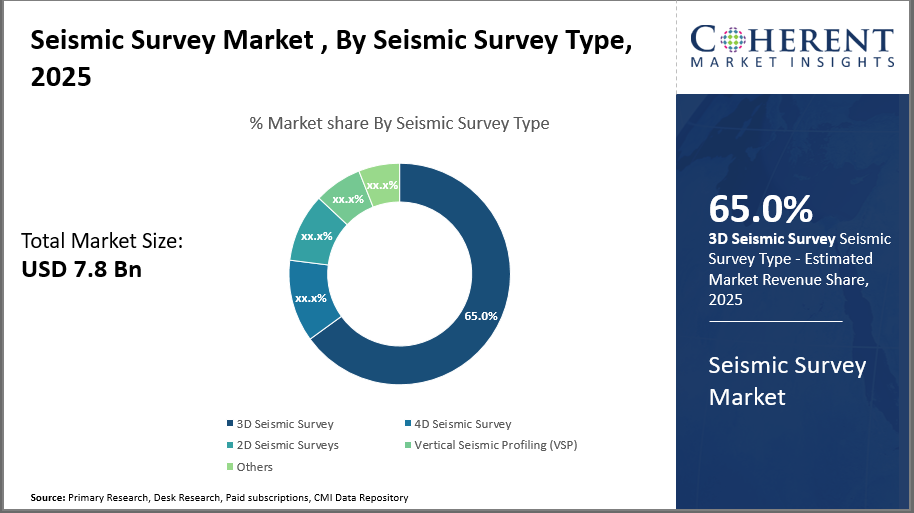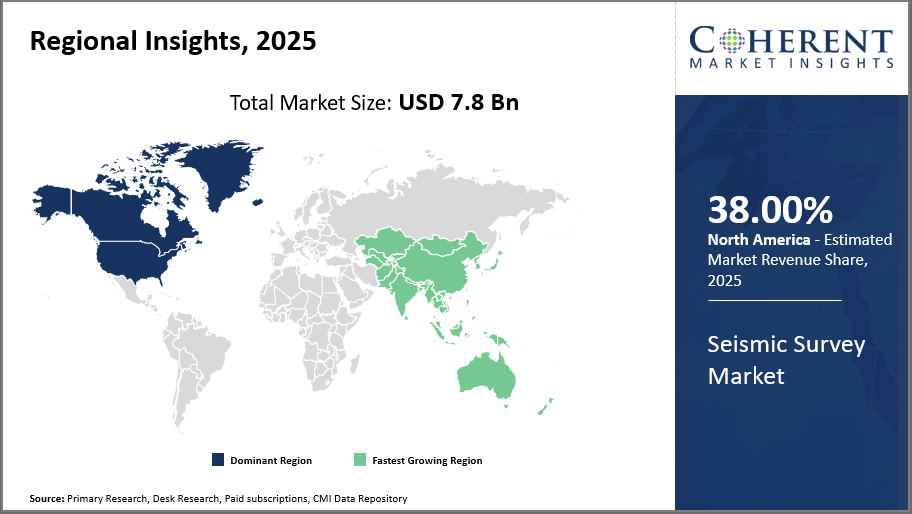Global Seismic Survey Market Overview
Seismic survey is a method used to investigate geological properties of earth and is majorly used to explore natural gas, petroleum, and mineral deposits. Data acquisition, processing, and interpretation are the three phases of seismic survey. This technique determines the time interval between the initiation of waves at a shot point and the arrival of reflected or refracted waves by the seismic detectors.
Various techniques including air guns, dynamite blast, and seismic vibrator among others are used for initiation of seismic waves. The amplitude and time are recorded on arrival of these waves at the detector. The time taken by wave to return to the surface gives several information such as types of rocks, possible fluids, and gases in the formation, providing a detailed image of the subsurface and the location of oil and gas reserves.
Seismic Survey Market Size and Forecast – 2025 – 2032
The Seismic Survey Market size is estimated to be valued at USD 7.8 billion in 2025 and is expected to reach USD 12.5 billion by 2032, exhibiting a compound annual growth rate (CAGR) of 7.6% from 2025 to 2032.
Key Takeaways
The 3D seismic survey segment continues to dominate due to its superior subsurface imaging capabilities, accounting for nearly 65% of the market share, thereby indicating the market’s preference for high-resolution analysis tools.
Marine seismic technology holds substantial market revenue, especially with offshore wind farm development becoming a significant use case in the renewable energy sector.
North America remains the leading region in terms of market revenue, leveraging a mature exploration ecosystem and strong regulatory frameworks.
Asia Pacific exhibits the highest CAGR driven by rapid infrastructure development and increasing exploration in previously under-explored basins like India and Southeast Asia.
Seismic Survey Market – Segmentation Analysis

To learn more about this report, Download Free Sample
Seismic Survey Market Insights, By Seismic Survey Type
The market is divided into several segments based on the kind of seismic survey, including 3D seismic survey, 2D seismic survey, 4D seismic survey, Vertical Seismic Profiling (VSP), and Others. Of these, 3D seismic survey holds a dominant market share of over 65%. This segment is preferable because it can provide high-resolution volumetric images that improve risk assessment and reservoir characterization.
Seismic Survey Market Insights, By Technology
The Technology segment consists of Marine Seismic, Land Seismic, and Transition Zone Seismic, with Marine Seismic maintaining market dominance because of its extensive use in offshore hydrocarbon exploration and growing renewable energy applications.
Seismic Survey Market Insights, By End User
Regarding end-user industries, segmentation includes Oil & Gas Exploration, Mining, Renewable Energy, Environmental Studies, Construction & Infrastructure, and Others. Oil & Gas Exploration commands the largest share due to sustained exploration and development activities, particularly in offshore Deepwater sectors.
Seismic Survey Market Insights, By Geography

To learn more about this report, Download Free Sample
North America Seismic Survey Market Analysis and Trends
The market domination of seismic surveys in North America is rooted in large exploration budgets and with market share of 38%, particularly in shale basins in the United States. Increased market expansion has been facilitated by the region's combination of technological leadership and access to deepwater and unconventional reserves. Advanced multi-azimuth and multi-component seismic surveys have been introduced by companies, improving imaging and attracting new project acquisitions in 2024. US companies that use proprietary technology to maximize survey costs and data accuracy, like Schlumberger and WesternGeco, play crucial roles.
Asia Pacific Seismic Survey Market Analysis and Trends
The Asia Pacific exhibits the fastest growth fueled by rapid industrialization and infrastructure expansion across India, China, and Southeast Asian nations. Growing energy needs and exploration of offshore and onshore basins have accelerated the adoption of seismic surveys, supported by favorable government initiatives and increasing foreign direct investment in energy sectors. Technological collaborations between domestic and international market companies have augmented service offerings, facilitating market traction at unprecedented levels.
Seismic Survey Market Outlook for Key Countries
Market Analysis and Trends for Seismic Survey in the United States
Due of the massive shale and offshore oil and gas exploration activities, the seismic survey business in the United States is still quite active. Recent statistics from 2024 showed that seismic acquisition contracts increased by more than 10% annually, supported by improved data processing techniques and advanced sensor deployments.
Prominent companies made large investments to create multi-client libraries, which expanded access to comprehensive seismic data and sped up project approvals. Furthermore, the government's focus on environmental compliance and infrastructure improvements is driving demand for seismic surveys across industries.
Market Analysis and Trends for Seismic Survey in the India
India's market for seismic surveys is growing quickly owing to government initiatives to build infrastructure and achieve domestic energy sufficiency. Seismic data collection for mineral and hydrocarbon exploration has accelerated because to programs like the National Seismic Programme.
The introduction of foreign service providers that facilitate technology transfers has decreased costs and enhanced survey quality. The historically oil-centric seismic market landscape is becoming more diverse as a result of the rise of renewable energy projects, particularly offshore wind, as major revenue generators.
Analyst Opinion
Production capacity in seismic survey services has seen considerable expansion, particularly in North America, where the U.S. ramped up acquisition activities by over 8% in 2024, contributing to a robust market supply profile. This surge is supported by increased capital expenditure by oil & gas companies, emphasizing exploration of unconventional reserves.
Demand-side metrics reveal a diversification of seismic applications beyond hydrocarbons; for instance, environmental and geotechnical surveys accounted for nearly 15% of total market revenue in 2024, driven largely by infrastructure and renewable energy projects, which increasingly rely on seismic technologies for subsurface characterization.
Micro-indicators reflect advancements in sensor technologies, such as nodal systems, that have reduced operational costs by approximately 20% year-over-year, as reported in 2025 field deployments, enabling enhanced deployment flexibility in difficult terrains.
Nano-sized signal processing innovations, leveraged by several field operators in 2024, enhanced data resolution by nearly 30%, influencing the accuracy and utility of seismic interpretations. This technical progression directly correlates with increased market adoption rates and higher contract values.
Market Scope
| Report Coverage | Details | ||
|---|---|---|---|
| Base Year: | 2025 | Market Size in 2025: | USD 7.8 billion |
| Historical Data for: | 2020 To 2024 | Forecast Period: | 2025 To 2032 |
| Forecast Period 2025 to 2032 CAGR: | 7.6% | 2032 Value Projection: | USD 12.5 billion |
| Geographies covered: |
|
||
| Segments covered: |
|
||
| Companies covered: | Schlumberger Ltd., CGG S.A., PGS ASA, Fugro N.V., TGS-NOPEC Geophysical Company, Polarcus Limited, BGP Inc., SAExploration Holdings, ION Geophysical Corporation, Geokinetics Inc. | ||
| Growth Drivers: |
|
||
Uncover macros and micros vetted on 75+ parameters: Get instant access to report
Growth factors
The seismic survey market growth is predominantly propelled by the resurgence of oil & gas exploration activities, especially in deepwater and ultra-deepwater basins where complex geological formations necessitate advanced seismic data acquisition.
Moreover, the shifting focus towards renewable energy projects such as offshore wind farms employs seismic surveys to evaluate seabed characteristics, thus broadening market scope.
Technological advancements like the integration of machine learning algorithms for seismic data processing have significantly improved survey accuracy and reduced operational timelines, fueling market revenue streams.
Another key driver is the increasing regulatory emphasis on environmental monitoring, mandating detailed seismic assessments for infrastructure projects, thereby opening new avenues for market companies to offer specialized services.
Seismic Survey Market Development
Market Trends
The seismic survey market is witnessing a paradigm shift driven by digitalization, with the adoption of cloud-based platforms for data storage and collaborative interpretation gaining traction since 2024. This trend enhances real-time decision-making and reduces project lead times.
Furthermore, the increased application of autonomous seismic nodes and drones in difficult-to-access regions has emerged as a pivotal innovation, expanding market potential, especially in the Asia Pacific and Africa regions.
Additionally, hybrid seismic surveys combining land and marine systems are becoming prominent to tackle complex geologies, as showcased in a major North Sea project in 2025 where hybrid acquisition reduced survey costs by 18%.
Key Players
Schlumberger Ltd.
CGG S.A.
PGS ASA
Fugro N.V.
TGS-NOPEC Geophysical Company
Polarcus Limited
SAExploration Holdings
ION Geophysical Corporation
Geokinetics Inc.
Among these market players, Schlumberger’s strategic investment in multi-client data libraries expanded its service portfolio and led to a 10% revenue growth in 2024, reflecting an effective market growth strategy. Likewise, Fugro’s adoption of hybrid acquisition technologies in 2025 enhanced their operational efficiency, contributing to faster turnaround times and reinforced competitive positioning.
Seismic Survey Market Future Outlook
The future outlook for the seismic survey market is positive, characterized by robust growth driven by increasing exploration and production activities, particularly in the oil and gas sector. Technological advancements such as 3D and 4D seismic imaging are enhancing data accuracy and resolution, enabling more efficient resource exploration and extraction. The market is also expanding beyond traditional sectors, with growing applications in mining, geothermal energy, and geological exploration.
Despite challenges like high initial costs and environmental concerns, the adoption of advanced data processing, artificial intelligence, and autonomous seismic acquisition systems is expected to improve operational efficiency and cost-effectiveness. Geographically, North America and Asia-Pacific are leading regions, while the Middle East, Africa, and parts of Europe show strong growth potential due to increased investments. Overall, the market is anticipated to experience continuous innovation and expansion fueled by rising energy demand, infrastructure development, and technological progress.
Historical Analysis
In January 2018, TGS announced commencement of three new 3D seismic projects in the basins of West Hackberry, Sanderson, and Dawson in North America. With this, TGS was in a stronger position of strengthening its onshore position. This enabled the company to help its customers in developing the best data-driven subsurface models in aiding their exploration efforts.
In April 2017, Shearwater GeoServices announced that it would conduct a 3D marine acquisition survey in offshore North Africa; and SeaBird Exploration announced a 2D seismic survey in offshore West Africa.
In April 2017, Explor Geophysical Ltd. launched PinPoint seismic technology that enabled ultra-high density seismic imaging of oil sands targets.
In August 2016, CGG launched TopSeis, offshore seismic technology. This was specifically designed with the objective of overcoming the intrinsic lack of near offsets inherent in 3D towed streamer industry.
Sources
Primary Research interviews:
Offshore Drilling Engineers
Geophysicists
Seismic Data Analysts
Databases:
Scopus
SpringerLink
ProQuest
Magazines:
World Oil
Offshore Magazine
Exploration & Production (E&P) Magazine
Journals:
Marine Geophysical Research
Exploration Geophysics
Interpretation (SEG & AAPG journal)
Newspapers:
Financial Times (Energy Section)
The Wall Street Journal (Energy & Commodities)
The Guardian (Energy/Environment)
Associations:
European Association of Geoscientists and Engineers (EAGE)
International Association of Geophysical Contractors (IAGC)
Share
Share
About Author
Yash Doshi is a Senior Management Consultant. He has 12+ years of experience in conducting research and handling consulting projects across verticals in APAC, EMEA, and the Americas.
He brings strong acumen in helping chemical companies navigate complex challenges and identify growth opportunities. He has deep expertise across the chemicals value chain, including commodity, specialty and fine chemicals, plastics and polymers, and petrochemicals. Yash is a sought-after speaker at industry conferences and contributes to various publications on topics related commodity, specialty and fine chemicals, plastics and polymers, and petrochemicals.
Missing comfort of reading report in your local language? Find your preferred language :
Transform your Strategy with Exclusive Trending Reports :
Frequently Asked Questions
Select a License Type
Joining thousands of companies around the world committed to making the Excellent Business Solutions.
View All Our Clients